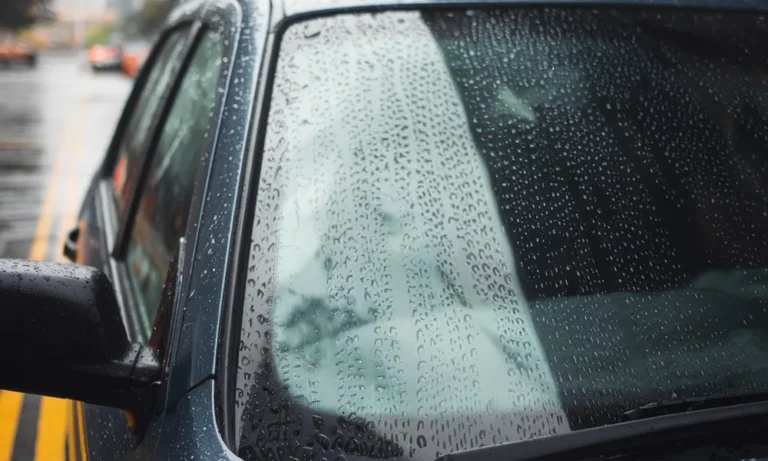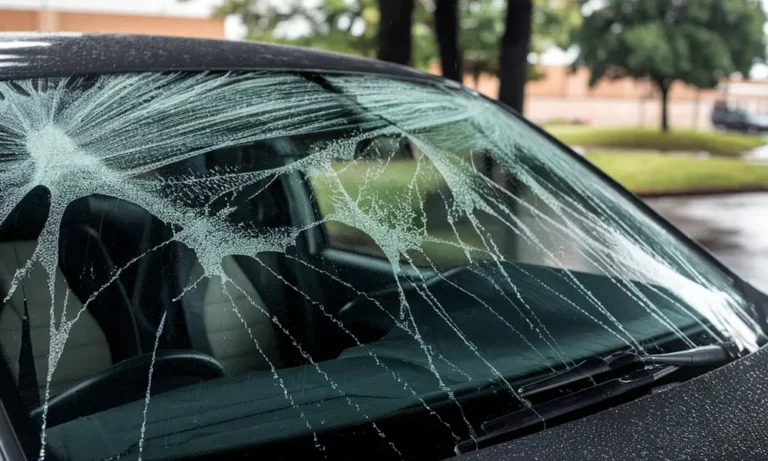What If It Rains After Windshield Replacement
What if it rains after windshield replacement? This is a common concern for vehicle owners who have just had their windshield replaced. Proper windshield installation and curing time are crucial to ensuring a secure and long-lasting bond between the glass and the vehicle. The adhesive used during installation needs time to cure, and exposure to moisture too soon can affect its effectiveness. However, light rain after windshield replacement is generally not a major issue if the adhesive has had some initial curing time. Auto glass technicians often use urethane adhesives that are designed to withstand some moisture. But heavy rain or car washes should be avoided immediately after installation to prevent any sealing issues. Always follow the recommended drying and curing time to ensure the best results.
Rain and Its Impact on Fresh Windshield Installations

When a new windshield is installed, adhesives are used to bond the glass to the frame. These adhesives need a curing time to reach full strength. The curing process depends on temperature, humidity, and the type of adhesive used. Most urethane adhesives require at least one hour for safe drive-away time, but full curing can take up to 24 hours.
Why Moisture Can Interfere with the Bonding Process
If a new windshield gets rained on before the adhesive has fully cured, moisture can weaken the bond. Water can seep into areas where the adhesive hasn’t set, preventing it from forming a strong seal. This can lead to leaks, poor adhesion, and even windshield shifting over time.
Common Issues Caused by Premature Exposure to Rain
- Water Leaks – If the adhesive doesn’t cure properly, gaps can form, allowing water to enter the vehicle.
- Weak Adhesion – Rain can compromise the bond, making the windshield more vulnerable to detachment in case of an accident.
- Reduced Structural Integrity – A windshield contributes to the overall strength of a vehicle. A poor bond due to moisture can affect safety.
If you’re wondering, Can a new windshield get rained on?, the answer is that it depends on how soon after installation it happens. Light rain after the adhesive has begun curing may not be a big issue, but heavy rain within the first few hours can affect the bond. To prevent problems, it’s best to follow the installer’s instructions and allow proper curing time before exposing the windshield to moisture.
If your car windshield is leaking you can contact Texas Reliable Auto Glass.
What If It Rains After Windshield Replacement?

Replacing a windshield involves using strong adhesives to bond the glass securely to the vehicle’s frame. However, these adhesives need time to cure properly. Rain or moisture during this curing process can sometimes interfere with the bond, leading to potential issues such as weak adhesion or water leaks. If you’ve recently had your windshield replaced and it starts raining, here’s what you should do to protect the installation and prevent problems.
Immediate Steps to Take if Rain Occurs
If rain starts falling right after your windshield replacement, don’t panic. Most professional installers use adhesives designed to handle some level of moisture. However, heavy rain or prolonged exposure to water can still impact the curing process. Here are some immediate steps to take:
- Avoid Driving Right Away – If possible, keep your car parked for at least a couple of hours to allow the adhesive to set. Driving in wet conditions too soon could cause the windshield to shift slightly, affecting the bond.
- Check for Water Leaks – After the rain, inspect the inside edges of your windshield. Run your hand along the seal and check for any moisture inside the car. If you notice damp spots, it could be a sign of improper bonding.
- Keep Windows Slightly Open – This helps regulate the humidity inside the car and prevents excess moisture from getting trapped, which could slow down the adhesive curing process.
- Gently Wipe Off Excess Water – If you see water pooling near the edges of the windshield, use a dry cloth to gently wipe it away. Do not apply pressure to the glass, as the adhesive might still be setting.
How to Minimize Potential Damage
To ensure your new windshield bonds properly and avoids issues caused by rain, take the following precautions:
- Park in a Covered Area – If rain is in the forecast, try to keep your car in a garage, under a carport, or any covered space to prevent excessive water exposure.
- Avoid Car Washes – High-pressure water jets and detergents from automatic car washes can weaken the adhesive before it fully cures. It’s best to wait at least 24 to 48 hours before washing your car.
- Do Not Remove the Retention Tape – Some installers apply retention tape around the edges of the windshield to keep it in place while the adhesive sets. Even if it doesn’t look great, leave it on for the recommended time to ensure a strong bond.
- Drive Carefully – If you must drive in the rain, do so cautiously. Avoid sudden stops, potholes, or rough roads that could cause unnecessary vibrations, which might affect the windshield’s position.
Manufacturer Recommendations for Safe Curing Times
The time it takes for the adhesive to fully cure depends on the type of urethane used and environmental conditions such as temperature and humidity. Here are general guidelines for curing times:
- 1 Hour for Safe Drive-Away Time – Some fast-curing urethane adhesives allow safe driving within an hour, but this does not mean the adhesive is fully set.
- 24 to 48 Hours for Full Curing – Most adhesives require at least a full day to reach maximum strength, and waiting longer is always better.
- Longer Curing Time in Cold or Humid Conditions – Low temperatures and high humidity can slow the curing process, so extra time may be needed before the adhesive reaches its full strength.
If you notice windshield leaks when it rains, it could indicate that the adhesive didn’t cure properly or there was an installation issue. Leaks can lead to foggy windows, interior damage, or even mold growth if left untreated. If you suspect a problem, contact your installer as soon as possible. They may need to check the seal and reapply adhesive if necessary.
For windshield replacement in Austin Tx you can contact us.
The Dangers and Repercussions of Ignoring Rain Exposure
A newly installed windshield needs time for the adhesive to cure properly. If rain exposure happens too soon, it can weaken the bond between the glass and the car’s frame, leading to serious issues. Ignoring the effects of rain after windshield replacement can compromise both the safety and durability of the installation.
Risks of a Weak Windshield Bond Leading to Leaks and Structural Issues
When moisture interferes with the adhesive before it fully cures, the windshield may not form a secure seal. This can result in several problems, including:
- Water Leaks – If the seal is not tight, gaps can allow moisture to enter the car. Over time, this can lead to mold growth, electrical malfunctions, and interior damage. Many drivers first notice the issue when their windshield leaks when it rains, which is a clear sign that the adhesive didn’t set properly.
- Reduced Structural Integrity – A windshield plays a critical role in the structural strength of a vehicle. In case of a rollover accident, a poorly bonded windshield may not support the car’s roof as intended, increasing the risk of serious injuries.
- Wind Noise and Loose Fit – A weak seal can cause excessive wind noise while driving, and in some cases, the windshield may shift slightly over time, further weakening its bond.
Safety Concerns in Case of an Accident
A windshield is more than just a barrier against wind and debris—it also helps keep passengers safe in a crash. A properly installed windshield:
- Supports Airbag Deployment – In many vehicles, airbags rely on the windshield to provide a stable surface for proper inflation. If the windshield is not securely bonded due to early rain exposure, the airbag might not deploy correctly, reducing protection for passengers.
- Prevents Ejection in a Collision – A weak windshield bond increases the chances of it popping out during a crash, raising the risk of passengers being ejected from the vehicle.
- Adds Structural Strength – In case of a head-on collision, a well-installed windshield helps distribute impact forces. If the bond is compromised, the glass may shatter or detach more easily.
The Need for Reinstallation if Damage Occurs
If you notice windshield leaks when it rains or experience excessive wind noise after installation, it’s essential to get the windshield inspected. If the adhesive did not cure properly due to rain after windshield replacement, a complete reinstallation may be necessary to restore safety.
Signs that indicate a problem requiring reinstallation:
- Persistent water leaks despite sealing attempts.
- Visible gaps or movement of the windshield.
- Cracks forming along the edges due to improper bonding.
You can also read about ford windshield replacement.
Final Thoughts
If it rains after windshield replacement, avoid driving immediately and check for leaks around the edges. Parking in a covered area and keeping windows slightly open can help minimize moisture impact. If you notice windshield leaks when it rains, it could mean the adhesive didn’t cure properly, which may require reinstallation. Ensuring a secure bond is crucial for your safety.
If you need windshield repair or replacement services, contact Texas Reliable Auto Glass at +1 737-346-1350 for professional and reliable service.
FAQs
1. What If It Rains After Windshield Replacement?
If it rains after your windshield replacement, avoid driving for at least a few hours to allow the adhesive to begin curing. Modern urethane adhesives are moisture-resistant, but excessive rain exposure too soon can weaken the bond.
2. Can Rain Affect The Curing Process Of My New Windshield?
Yes, heavy rain or prolonged moisture exposure can interfere with the adhesive’s ability to fully cure, potentially leading to weak adhesion, leaks, or wind noise. It’s best to follow your installer’s recommended curing time.
3. How Can I Protect My New Windshield From Rain After Replacement?
Park your car in a covered area, leave the retention tape in place, and avoid using car washes for at least 24-48 hours. Keeping your windows slightly open can also help reduce moisture buildup inside the car.
4. What Are The Signs Of Improper Curing Due To Rain?
If you notice windshield leaks when it rains, hear unusual wind noise while driving, or see moisture inside the vehicle, the adhesive may not have set correctly. These issues require professional inspection and possible resealing.
5. Do I Need To Replace My Windshield Again If It Gets Wet Too Soon?
Not necessarily. If the windshield is properly installed and the adhesive had some time to set before the rain, it may still bond well. However, if you experience leaks or loosening, you may need a reinstallation.

